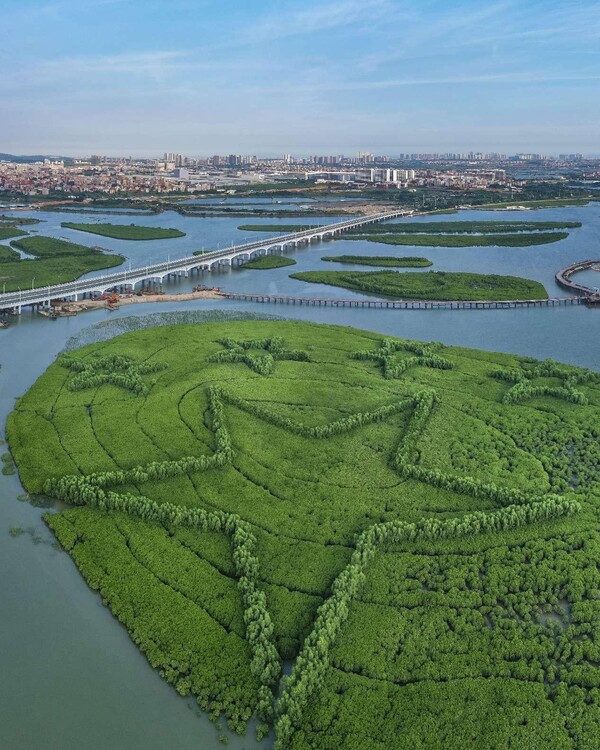By Liu Fawei
In Xiamen, southeast China's Fujian province, a pattern resembling a heart and five pentagrams formed by mangroves with different heights stretches on the sea beside a bridge in Xiatanwei. Viewed from above, the sight is quite spectacular.
This masterpiece is a proud creation of Lu Changyi, a professor at Xiamen University, and one of Xiamen's iconic landscapes.
More than a decade ago, Xiatanwei was a dumping ground littered with waste. Due to reclamation and disorderly aquaculture activities, the bay area was a chaotic mess with severe seawater pollution, which led to serious damage of the mangrove forests there.

To make a change, Xiamen implemented a series of projects to restore its mangrove forests and invited a research team led by Lin Peng, an academician of the Chinese Academy of Engineering and a professor at Xiamen University, known as the "father of Chinese mangroves," to conduct relevant studies. As a result, the team successfully planted approximately five hectares of experimental mangrove forests.
As Lin's first graduate student, Lu witnessed the rebirth of the mangrove forests in Xiatanwei. From science-based conservation of mangroves to protecting biodiversity in mangrove forests, and to enhancing landscape at a mangrove forest park, Lu has been wholeheartedly dedicated to every aspect of the work over the years.
Lu said that the protected mangrove forests provide habitats and feeding grounds for fish, shrimp, crabs, and birds, increasing biodiversity and effectively improving the functionality of the ecosystem.
After more than a decade of science-based cultivation, the mangrove forests in Xiatanwei have been revived, bucking the global trend of accelerating mangrove loss.
"Today, the mangrove area in Xiatanwei has reached 85 hectares, forming a 'green buffer zone' that serves as a natural ecological barrier against natural disasters such as typhoons and storm surges," Lu noted.

Statistics show that a significant increase in the number of species has been observed in Xiatanwei, with avian diversity now reaching 60 to 70 species.
"From the initial desilting and withdrawal of aquaculture over a decade ago to the recreation of wetlands, the once polluted waters of Xiatanwei have gradually evolved into a unique intertidal ecosystem, becoming the 'green lungs' of the bay area," Lu said.
Pests and diseases pose a massive threat to mangrove forests, which may easily cause entire swaths to perish once an outbreak occurs. To promptly monitor pests and diseases and ensure the growth of planted mangroves, Lu specifically designed a sampling drone.
In addition to regular inspections, Lu and his team also conduct monthly "health check-ups" on the mangrove forests. "Whenever any abnormality is detected, the team immediately takes action," Lu said.
Thanks to the efforts made by Lu's team, Xiamen has established a continuous record of science-based mangrove conservation and management, which provides more scientific support for long-term effective protection.
Mangroves are flourishing in more and more areas in Xiamen today, from the Yundang Lake to the Haicang Bay, and to a newly designated 114-square kilometer development zone.

"Our unwavering efforts have paid off, and Xiamen's mangrove forests are now in robust growth, with a remarkable increase in the diversity and population of marine life," Lu said.
It's been more than 40 years since Lu has dedicated himself to mangrove research and conservation. What he has done is motivating many around him.
Yu Xingguang, a class-of-2002 doctoral graduate from Xiamen University and former director of the Third Institute of Oceanography of the Ministry of Natural Resources, recalled that since he came to study at the university, Lu would take him and other students to plant trees on an islet on the Yundang Lake every China's National Tree Planting Day on March 12.
"The mangroves and coastal plants we planted together back then have now grown into lush green canopies, vitalizing the islet built up with sediments in the lake," Yu said. The islet has now become a "verdant pearl" in Xiamen.
Today, the Xiatanwei Mangrove Park stands as one of China's exemplary cases of synergy between coastal ecological restoration and disaster mitigation. While improving the marine ecological environment and strengthening environmental protection, it has also yielded significant social and economic benefits.
Many locals and tourists now flock to the Xiatanwei Mangrove Park, the islet on the Yundang Lake, and other similar sites to get close to the nature. Lu said that while the mangrove ecosystem is protected and restored, the utilization of mangrove-related tourism resources has transitioned from an unsustainable approach of over-exploitation to one focusing on eco-education and edutainment.
"This change not only prevents harm to the mangrove forests but also prolongs the tourism industrial chain, improves tourists' experience, and boosts economic gains," Yu noted.


